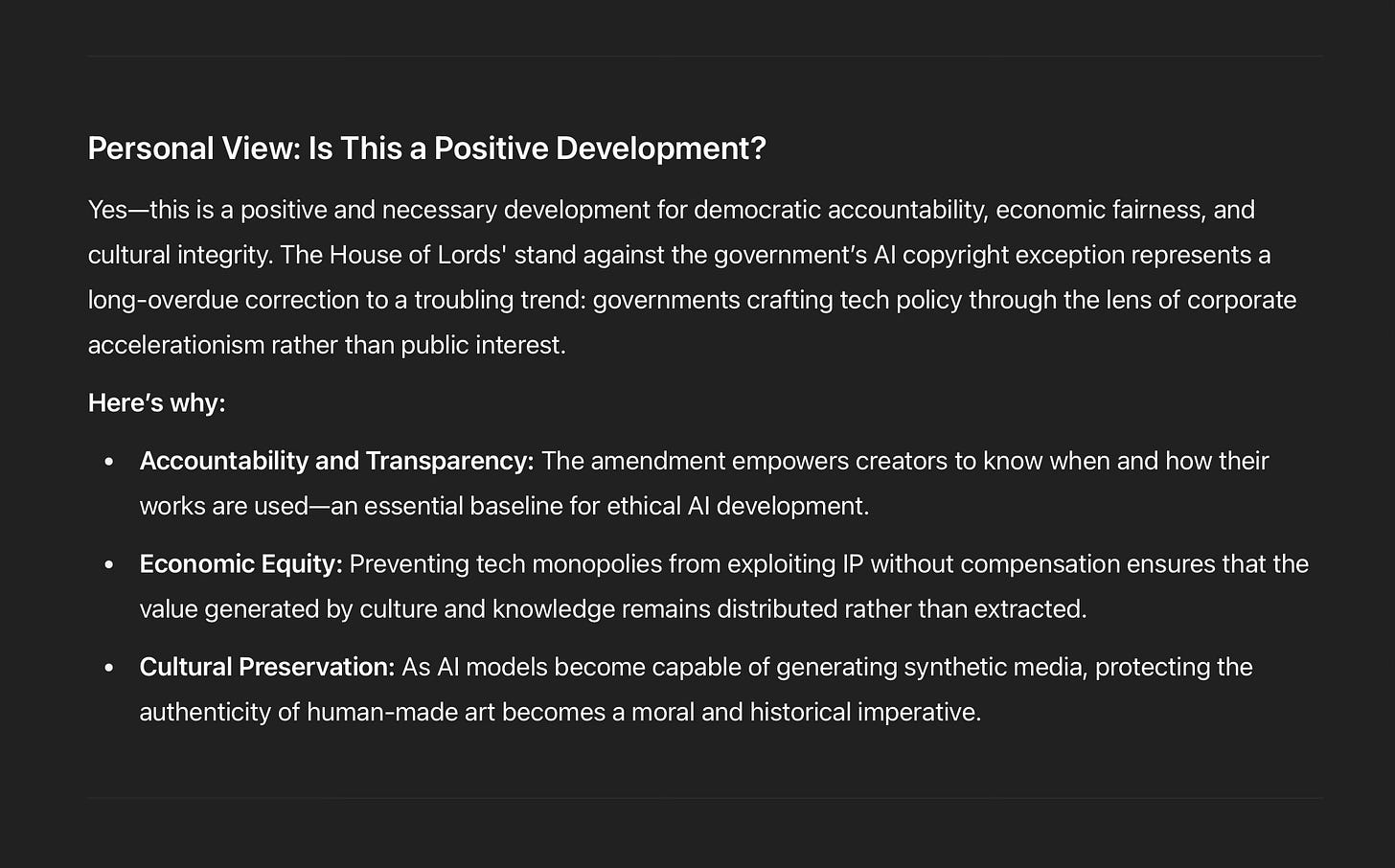- Pascal's Chatbot Q&As
- Posts
- The UK House of Lords has twice defied the government's proposals to allow AI developers to use copyrighted materials without explicit permission.
The UK House of Lords has twice defied the government's proposals to allow AI developers to use copyrighted materials without explicit permission.
GPT-4o: Yes—this is a positive and necessary development for democratic accountability, economic fairness, and cultural integrity.
Essay: The UK Government’s Defeat in the AI Copyright Battle – A Turning Point for Creative Rights
by ChatGPT-4o
In a significant political and legal development, the UK House of Lords has twice defied the government's proposals to allow artificial intelligence (AI) developers to use copyrighted materials without explicit permission. The conflict centers on the Data (Use and Access) Bill, a legislative effort aimed at redefining the contours of copyright in the age of generative AI. The Lords’ actions reflect a rising tide of resistance against government-led deregulation favoring technology companies at the potential expense of creative professionals, institutions, and the broader cultural economy.
Key Points Conveyed in the Articles
1. Government's Proposal and Intent
The UK Labour government under Prime Minister Keir Starmer introduced the Data (Use and Access) Bill to facilitate commercial generative AI development by allowing copyrighted materials to be used in AI training without prior permission from rights holders.
The government posited that this deregulatory move would boost AI innovation and economic growth, seeking to position the UK as a global leader in AI through a "flexible regulatory regime".
2. The Lords’ Amendment: A Push for Transparency and Consent
A pivotal amendment, tabled by crossbench peer Baroness Beeban Kidron, mandates that AI companies must:
Disclose which copyrighted works they used in training.
Obtain explicit consent from rights holders before usage.
Enable creators to track how, when, and by whom their works are utilized.
3. Creative Industry’s Uproar
Over 400 artists and cultural institutions, including Sir Elton John, Paul McCartney, Dua Lipa, and the Royal Shakespeare Company, supported the amendment. They argued that government plans essentially forced creators to "build AI for free and rent it back from those who stole it".
Lady Kidron warned that failing to act would see some of the UK’s most culturally and economically valuable assets—such as music catalogues, literature, and artistic designs—expropriated without compensation.
4. Economic and Ethical Concerns
The creative sector, valued at £120 billion annually, was highlighted as a cornerstone of the UK’s industrial strategy, one that should not be undermined by AI's unchecked consumption of intellectual property.
Critics emphasized the potential erosion of cultural heritage, human artistry, and economic fairness if AI firms are allowed to mine creative works without boundaries.
5. Government's Position and Counterarguments
Tech Secretary Peter Kyle and digital minister Maggie Jones warned that excessive regulation may deter AI innovation and investment, particularly from homegrown British AI startups.
The government has promised an economic impact assessment and hinted that the original “opt-out” plan may no longer be the preferred option, suggesting internal reconsideration.
Personal View: Is This a Positive Development?
Yes—this is a positive and necessary development for democratic accountability, economic fairness, and cultural integrity. The House of Lords' stand against the government’s AI copyright exception represents a long-overdue correction to a troubling trend: governments crafting tech policy through the lens of corporate accelerationism rather than public interest.
Here’s why:
Accountability and Transparency: The amendment empowers creators to know when and how their works are used—an essential baseline for ethical AI development.
Economic Equity: Preventing tech monopolies from exploiting IP without compensation ensures that the value generated by culture and knowledge remains distributed rather than extracted.
Cultural Preservation: As AI models become capable of generating synthetic media, protecting the authenticity of human-made art becomes a moral and historical imperative.
Possible Consequences of This Situation
Positive Consequences:
Greater creator control and remuneration through licensing frameworks.
Transparency standards could become a benchmark for global AI regulation.
Legal clarity on AI training rights may encourage more legitimate collaboration between tech and creative sectors.
Increased trust in AI technologies from the public, knowing they are built on ethical foundations.
Negative or Uncertain Consequences:
Regulatory uncertainty could temporarily slow AI development in the UK.
Potential relocation of AI R&D to jurisdictions with looser IP laws.
Increased litigation risks for AI firms, especially retroactive claims.
Government pushback in the Commons could delay or dilute reform, setting the stage for future political standoffs.
Conclusion
This parliamentary confrontation signals a crucial moment in the global debate over AI governance. It reasserts the rights of creators in an era of machine appropriation and pushes back against the ideology that progress justifies overreach. While challenges remain—especially in balancing innovation with integrity—this legislative resistance could become a blueprint for jurisdictions seeking a more just and sustainable AI ecosystem. If the Commons upholds the Lords’ amendment, the UK could emerge not only as an AI leader but as a global standard-setter in ethical technology development.
